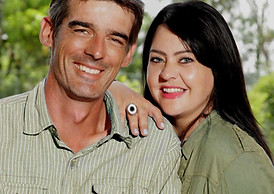








South Africa is calling. The cheetahs are waiting. Your adventure starts here ... Volunteering isn’t just about giving - it’s about learning, growing, and leaving with a deeper understanding of life, nature, and the urgent need to protect it. It’s a chance to make a difference. Become a guardian of the wild, a voice for the voiceless, and part of a movement ensuring cheetahs and other wildlife thrive for generations to come.

The Story of Running Wild Conservation With more than 32 years of combined experience, founders Des and Elizke have devoted most of their lives to the protection and care of wildlife. What began as a passion for conservation has grown into a lifelong mission — one that extends far beyond the plight of the Southern African cheetah to include a wide variety of species in need of rescue, rehabilitation, and lifelong sanctuary care. A Lifeline for Wildlife Over the years, Running Wild has welcomed an astonishing diversity of animals. From orphaned antelope, monkeys, squirrels, bush babies, and even the occasional rat or mouse, to rescued predators like servals, genets, caracals, leopards, lions, hyenas, and birds of prey — each animal that arrives has a story and a chance at healing. Some are nurtured until they are strong enough to return to the wild. Others, unable to survive on their own, find a permanent and loving home within the sanctuary. A Special Focus on Cheetahs While our work encompasses many species, our greatest passion and focus lies with the Southern African cheetah, one of Africa’s most endangered large carnivores. With wild populations under increasing threat, we are committed to restoring their numbers through our proven ten-step rewilding program. This program carefully prepares captive-born cheetahs for life in protected reserves, ensuring they have the skills, strength, and instincts needed to survive and contribute to the genetic diversity of the wild population. Forever Homes with Dignity For the few animals that cannot be returned to the wild, Running Wild offers a safe haven where they can live out their lives with dignity. Our sanctuary provides expansive, natural enclosures, carefully designed enrichment activities, and tailored nutrition — ensuring every animal experiences comfort, security, and the chance to express natural behaviors. We believe strongly that the outdated practice of euthanizing animals simply because they cannot be released has no place in ethical conservation. Every life deserves a second chance. The Power of Education Through our work, we have learned that conservation is not only about saving animals today but also about shaping the future. Education has become one of our most powerful tools. We engage with a wide spectrum of learners — from international pre-veterinary students and interns seeking hands-on experience to children from our local communities who are inspired by their first encounters with wildlife. By teaching both knowledge and compassion, we aim to ignite a passion for conservation that will endure across generations. Our Legacy The mission of Running Wild Conservation is twofold: to ensure the survival of the Southern African cheetah and to nurture a generation of people who will continue to defend and protect our natural heritage. Wildlife is the greatest gift humanity has been entrusted with, and our legacy will be to safeguard it — not just for today, but for all the tomorrows to come. Every animal deserves a chance. Every generation deserves a future. Together, we can protect both

Every day at Running Wild, we care for animals who have nowhere else to turn. From life-saving veterinary treatments to nutritious food and enriching activities, our work depends on the generosity of supporters like you. A donation via PayPal or bank transfer goes directly to: Veterinary care for injured and sick animals Nutritious food for all our residents Enrichment activities that keep animals healthy and engaged as well as sufficient shelters and spacious enclosures No contribution is too small — every donation helps make life at Running Wild safer, healthier, and more fulfilling for the animals in our care. Give the gift of hope. Give the gift of life.